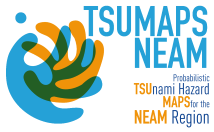The goal of Earthquake Model is the revision of potentially tsunamigenic seismic source characterization, based on the harmonization of the results achieved in ASTARTE and in several other EU and national projects, including some on seismic hazard (e.g. SHARE).
The earthquake model has been already developed and is being already extended to most of the NEAM region during ASTARTE and Italian PTHA activities. Here, the existing model will be revised and extended where necessary for TSUMAPS-NEAM purposes. Hence, the earthquake model will cover all potentially tsunamigenic source zones that are relevant for the coasts of the NEAM region. The whole source area will be subdivided into seismic regions based on review of geologic and tectonic features. Each of these regions will be characterized in terms of maximum magnitude, depth range, rigidity, possible fault geometries and focal mechanisms, and seismic activity rates. The characterization of each region will also include the collection and the critical review of all available seismic and focal mechanism catalogues, the reassessment of their completeness periods, and the evaluation of completeness and epistemic reliability of fault databases. A special treatment will be adopted for subduction interfaces, where the largest tsunami sources are expected. 3D geometry, seismogenic areas and activity rates will be defined, paying particular attention to shallow thrust regions and slip heterogeneity for large earthquakes in the nearfield of the target shorelines.
A gridded model will be produced, providing the probability in each cell for both crustal and subduction earthquake occurrence, merging information from the seismicity and fault catalogues. The gridded model will include several alternative seismicity models.
